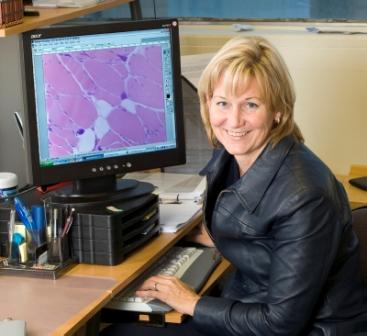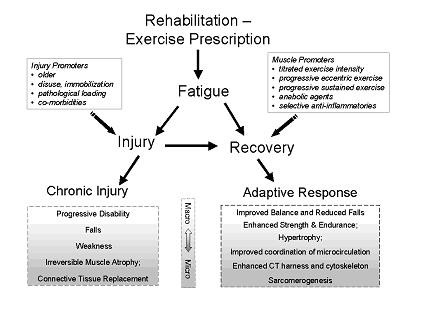Professor,
|
 |
Academic Credentials
Academic Affiliations
Areas of Research Interest
- Diaphragm Injury in Animal Models and people
- Shift to Research with More Apparent Clinical Relevance
- Knowledge Translation
- Research Framework
Selected Publications
Recent and Current Grants
Teaching
Professional Practice
Memberships/Honours
ACADEMIC CREDENTIALS
- PhD (Pathology), University of British Columbia in 1988
- BMR(PT), University of Manitoba in 1979
ACADEMIC AFFILIATIONS
- Investigator, Vancouver Coastal Health Research Institute
- Professor, Physical Therapy Division, University of British Columbia
- Faculty, School of Human Kinetics, University of British Columbia
AREAS OF RESEARCH INTEREST
My research has been focused on issues related to exercise training, and skeletal muscle and respiratory physiology. A central theme of much of my research is exertion-induced skeletal muscle injury in animal and human models of physiologic and pathologic loading. Other aspects of my scholarly work has examined the benefit of different interventions in pulmonary rehabilitation, systematic reviews, and participation in knowledge translation.
Top
Diaphragm Injury in Animal Models and People
A major achievement in my research is identifying and examining mechanisms of exertion-induced skeletal muscle injury in response to low intensity pathologic loading. I have developed an animal of resistive loading, which is associated with hypercapnic ventilatory failure and diaphragm injury. I have explored different mechanisms that contribute to diaphragm injury in this animal model of low intensity resistive loading and a high intensity inspiratory resistive loading model. These studies have included examining the involvement of inflammation (specifically neutrophil mediated injury and increased expression of adhesion molecules) and calpain mediated injury. In order to determine the clinical relevance of diaphragm injury, I embarked on two main areas of clinical investigation. I characterized diaphragm injury in people from biopsies obtained post-mortem and during thoracotomy in collaboration with Dr. Jeremy Road. Two paper have been published (see MacGowan et al. and Scott et al.) and another is currently under review. More recently, I have extended my collaborations with Orthopedic Trauma Team at VCHRI and have been examining limb muscle biopsies for their structural and functional attributes.
Top
Shift to Research with More Apparent clinical Relevance
During the first part of my career at UBC, I was struck by the desire of physiotherapist research trainees to perform research with a very apparent clinical focus. My work on diaphragm injury in animal models was very successful from a publication and granting perspective, however, I decided to refocus my research in areas that might be more clinically appealing to trainees recruited to the Rehabilitation Sciences. Part of this shift involved studies exploring diaphragm and limb muscle injury in people with chronic respiratory disease and my collaborations in the performance of systematic reviews and clinical practice guidelines. I continue to explore my research questions with both clinical and animal models to complement my clinical findings with mechanistic investigations.
Top
Knowledge Translation
As a clinical scientist, I have a firm commitment to knowledge translation. This has been exemplified by my role on national committees contributing to the development, dissemination, and implementation of clinical practice guidelines. As mentioned above, I’m involved in a national collaboration on systematic reviews of inspiratory muscle training and aerobic training of the extremities. I’ve recently been funded for a knowledge translation study to examine two different ways of increasing the prescription of exercise that is evidence-based.
Top
From my research to date and in collaboration with my colleagues, we have developed a research framework for addressing exercise prescription to optimize outcomes in people with chronic disease.

After receipt of a team planning grant from the Michael Smith Foundation for Health Research, I will lead a “Rehabilitation Aimed at Muscle Performance” (RAMP) Team to determine the therapeutic dose-response of exercise protocols that maintain mobility and independence in elderly people with chronic conditions. To date, most exercise protocols have been devised for young healthy adults, and do not consider how aging and co-morbidities predispose muscle to injury and delay recovery. We will identify ways to prescribe exercise and activities while monitoring adaptation and muscle injury in order to optimize participation in the elderly. The innovative characteristics of our team include the ability to explore the dose-response of rehabilitative exercise protocols in the elderly with chronic disease(s) across the spectrum from molecular to clinical studies. The overall objective of our research team is to develop safe, effective exercise programs that are appealing and readily adhered to by older adults.
Top
SELECTED PUBLICATIONS (Past 3 years)
- Roig M, Eng JJ, Road JD, Reid WD. Falls in patients with chronic obstructive pulmonary disease: a call for further research. Respir Med 2009; 103(9):1257-69.
- Roig M, O’Brien K, Kirk G, Murray R, McKinnon P, Shadgan B, Reid WD. The
effects of eccentric versus concentric resistance training on muscle
strength, mass, fiber characteristics in health adults: a systematic
review with meta-analyses. Br J Sports Med 2009; 43(8):556-68. - Roig M, Reid WD. Electrical stimulation and peripheral muscle function in COPD: a systematic review. Repir Med 2009; 103(4) 185-95.
- Sheel AW, Reid WD,
Townson AF, Ayas NT, Konnyu KJ, Spinal Cord Rehabilitation Evidence
Research Team. Effects of exercise training and inspiratory muscle
training in spinal cord injury: a systematic review. J Spinal Cord Med 2008; 31(5):500-8. - Geddes EL, O’Brien K, Reid WD, Brooks D, Crowe J. Inspiratory muscle training in adults with chronic obstructive pulmonary disease: An update of a systematic review. Respir Med 2008; 102(12):1715-29.
- Reid WD, Geddes L, O’BrienKO, Brooks D, Crowe J. Effects of inspiratory muscle training in cystic fibrosis. A systematic review. Clinical Rehab2008;22:1003-13.
- Shadgan B, Menon M, O’Brien PJ, Reid WD. Diagnostic techniques in acute compartment syndrome of the leg, a review article. J Ortho Trauma2008; 22(8):581-7.
- Roig M, Shadgan B, Reid WD. Eccentric exercise in patients with chronic conditions: A systematic review. Physiotherapy Canada2008; 60:147-160
- Mathur S, Vetter KPR, MacIntyre DL, Reid WD. Estimation of thigh muscle mass using magnetic resonance imaging in older adults and people with COPD. Phys Ther. 2008; 88(2):219-30
- O’BrienKO, Geddes L, Reid WD, Brooks D, Crowe J. Inspiratory
Muscle Training Compared with Other Rehabilitation Interventions in
Chronic Obstructive Pulmonary Disease: A Systematic Review Update. Journal of Cardiopulmonary Rehabilitation and Prevention2008; 28:128-41. - Reid WD, Stanton S, Kelm LC. Factors associated with interest in cardiorespiratory continuing education using computer-assisted learning. Physiotherapy Canada 2008; 60:80-91.
- Geddes L, Reid WD, O’BrienKO, Brooks D, Crowe J. Does Aerobic Exercise Training Improve Inspiratory Muscle Function in Individuals with Chronic Obstructive Pulmonary Disease? A Systematic Review. Cardiopulmonary Physical Therapy 2007; 18:3-13.
- Mathur S, MacIntyre DL, Forster BB, Road JD, Levy RD, Reid WD. Preservation of eccentric torque of the knee extensors and flexors in people with COPD. Journal of Cardiopulmonary Rehabilitation and Prevention 2007;27:411-416.
- Reid WD,
Sharma A, Elliott WM, Davies JE, Road JD. Diaphragm morphology post
mortem in people with acute and chronic respiratory disease. Cardiopulmonary Physical Therapy 2007; 18:3-12. - Reid WD, Kelm C, Hopkins-Rosseel D, Brooks D. The Canadian Thoracic Society recommendations for management of chronic obstructive pulmonary disease. Implications to physiotherapists. Physiotherapy Canada 2007; 59:218-228.
Top
RECENT AND CURRENT GRANTS HELD FROM:
- Michael Smith Foundation
- British Columbia Lung Association
- British Columbia Medical Services Foundation
- Canadian Health Research Professionals of the Lung Association
- Canadian Institutes of Health Research
TEACHING
I provide instruction on topics directly related to my research, and on issues relating to exercise physiology, patient care of cardiorespiratory patients, and research design. My interest in entry-level cardiorespiratory practice is reflected in a recently published textbook titled “Clinical Management Notes and Cases Histories in Cardiopulmonary Physical Therapy.” Most years, I am involved in entry-level instruction to physiotherapy students at the University of British Columbia, research graduate student instruction, continuing education, and presentation of research and other scholarly work.
My teaching also extends to the national and international level including American physiotherapy and respiratory meetings, “Curso-Taller Internacional de Rehabilitacion Respiratoria Integral” in Mexico City; invited presentations in Auckland and Christchurch, New Zealand, and most recently to Nagasaki and Ube, Japan.
Top
PROFESSIONAL PRACTICE
Has focused on people with respiratory disease especially those involved in pulmonary rehabilitation.
Top
MEMBERSHIPS/HONOURS
- Honorary membership, Canadian Physiotherapy Association
- Recognition Award from the Canadian Cardiorespiratory Physiotherapy Society of the Lung Association
- UBC Izaak Walton Killam Memorial Faculty Research Fellowship
- B.C. Health Care Research Foundation Scholarship
- PABC Research Award, Physiotherapy Association of BC